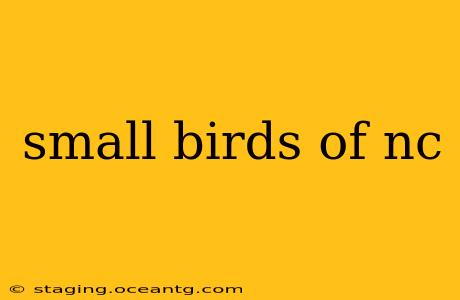North Carolina boasts a vibrant avian population, with numerous small bird species calling the state home. From bustling city parks to tranquil mountain forests, these tiny creatures add a melody and vibrancy to the landscape. This comprehensive guide will explore some of the most common and fascinating small birds you'll encounter in North Carolina, addressing frequently asked questions along the way.
Identifying Small Birds in NC: Key Characteristics
Before diving into specific species, let's discuss how to identify small birds. Pay attention to these key characteristics:
- Size: While "small" is relative, consider the bird's overall size compared to common birds like robins or cardinals.
- Plumage: Note the color, pattern, and texture of the feathers. Are they predominantly one color, or do they exhibit striking patterns?
- Behavior: Observe the bird's foraging habits, flight patterns, and calls.
- Habitat: Where did you see the bird? Different species prefer different environments (woodlands, fields, wetlands).
Common Small Birds of North Carolina
Here are some of the most frequently sighted small birds in North Carolina:
-
Carolina Wren: Known for its cheerful song and reddish-brown plumage, the Carolina Wren is a common sight in gardens and woodlands. They are bold and often forage close to humans.
-
Tufted Titmouse: A gray bird with a prominent crest, the Tufted Titmouse is a year-round resident of North Carolina, often found in forests and parks. They are active and inquisitive foragers.
-
Chickadee (Black-capped & Carolina): These tiny, energetic birds are easily recognized by their black cap and bib, and their cheerful "chick-a-dee-dee-dee" call. North Carolina supports both the Black-capped and Carolina Chickadees, with subtle differences in appearance and range.
-
House Wren: Similar in size to the Carolina Wren, but with a less boldly marked plumage and a more persistent and busier foraging style. These birds are common near human dwellings.
-
Downy Woodpecker: The smallest woodpecker in North Carolina, the Downy Woodpecker is easily identifiable by its black and white markings and its habit of foraging on tree trunks.
-
Ruby-crowned Kinglet: A tiny, olive-green bird with a hidden ruby-red crown on the male, the Ruby-crowned Kinglet is a winter visitor to North Carolina.
-
Golden-crowned Kinglet: Similar to the Ruby-crowned Kinglet, this species also displays a crown—but yellow instead of red.
What are some small brown birds in NC?
Many small birds in North Carolina exhibit brown plumage, making identification challenging. This includes several sparrows, wrens, and even some juvenile birds of other species. To differentiate them, you need to focus on subtle differences in feather markings, size, shape, and behavior. Consider using a field guide or bird identification app to help narrow down possibilities based on location and observed features.
What is the smallest bird in North Carolina?
While precise measurements vary, the Ruby-crowned Kinglet and the Golden-crowned Kinglet are contenders for the title of smallest bird in North Carolina. Both are exceptionally tiny and lightweight.
What are some small yellow birds in NC?
Several small yellow birds can be found in North Carolina, including the American Goldfinch, known for its vibrant yellow plumage during breeding season, and the Yellow-rumped Warbler, a common winter visitor with a distinctive yellow rump patch.
What small birds visit my backyard feeder?
The types of small birds that visit your backyard feeder depend on the type of food you offer. Offering seeds will attract birds like finches and sparrows. Suet will attract woodpeckers. Providing nectar feeders will attract hummingbirds. Consider providing a variety of food sources to attract a diversity of species.
How can I attract small birds to my yard?
Creating a bird-friendly environment in your yard involves providing food, water, and shelter. Planting native shrubs and trees provides food and shelter, while a birdbath offers a crucial water source. Avoid using pesticides, as they can harm birds and their food sources.
This guide provides a starting point for exploring the fascinating world of small birds in North Carolina. Remember to utilize field guides, bird identification apps, and local birdwatching resources to further enhance your knowledge and enjoyment of these avian wonders. Happy birding!
